Paralysis results in loss of muscle control and even speech in certain cases. Physical therapy has yielded the best results for Paralysis / Stroke patients with long term concentration on Muscles, exercise to stimulate the nerves and by performing occupational therapy to improve the daily active living.
The patients have to take the support of mobility aids and supporting devices such as braces and walkers initially. Spontaneous recovery is possible for the cases like Bell’s palsy which is a temporary paralysis of the face.
The activity-based therapy includes training from bed to wheelchair and vice versa, gait training using walker, harness based walker, taking stairs, helping to improve bladder control along with building the upper extremities strength and total body conditioning.
There are two main types of stroke:
Ischemic strokes occur as a result of an obstruction (clot) within a blood vessel supplying blood to the brain and account for 87 per cent of all stroke episodes.
Hemorrhagic strokes result from a weakened blood vessel that ruptures and bleeds into the surrounding brain.
The goal in rehabilitation is to improve function so that the stroke survivor can become as independent as possible. This must be accomplished in a way that preserves dignity while motivating the survivor to relearn basic skills the stroke may have taken away – such as eating, dressing and walking.
-> Self-care skills such as feeding, grooming, bathing, and dressing.
-> Mobility skills such as transferring, walking, or moving a wheelchair.
-> Communication skills; cognitive skills such as memory or problem-solving.
-> Social skills for interacting with other people.


Reducing the number of controllable risk factors is the best way to prevent a stroke. Here are 10 things you can do to stay stroke-free:
1. Know and control your blood pressure.
2. Don’t smoke; stop if you do.
3. Lose weight if needed.
4. Become more active.
5. Identify and manage atrial fibrillation.
6. Be aggressive about treating a transient ischemic attack (TIA, or mini-stroke).
7. Treat circulatory problems like peripheral artery disease, sickle cell disease, or severe anaemia.
8. Know and control your blood sugar and cholesterol.
9. If you drink alcohol, do so in moderation.
10. Adopt a healthy diet low in sodium and rich in potassium.